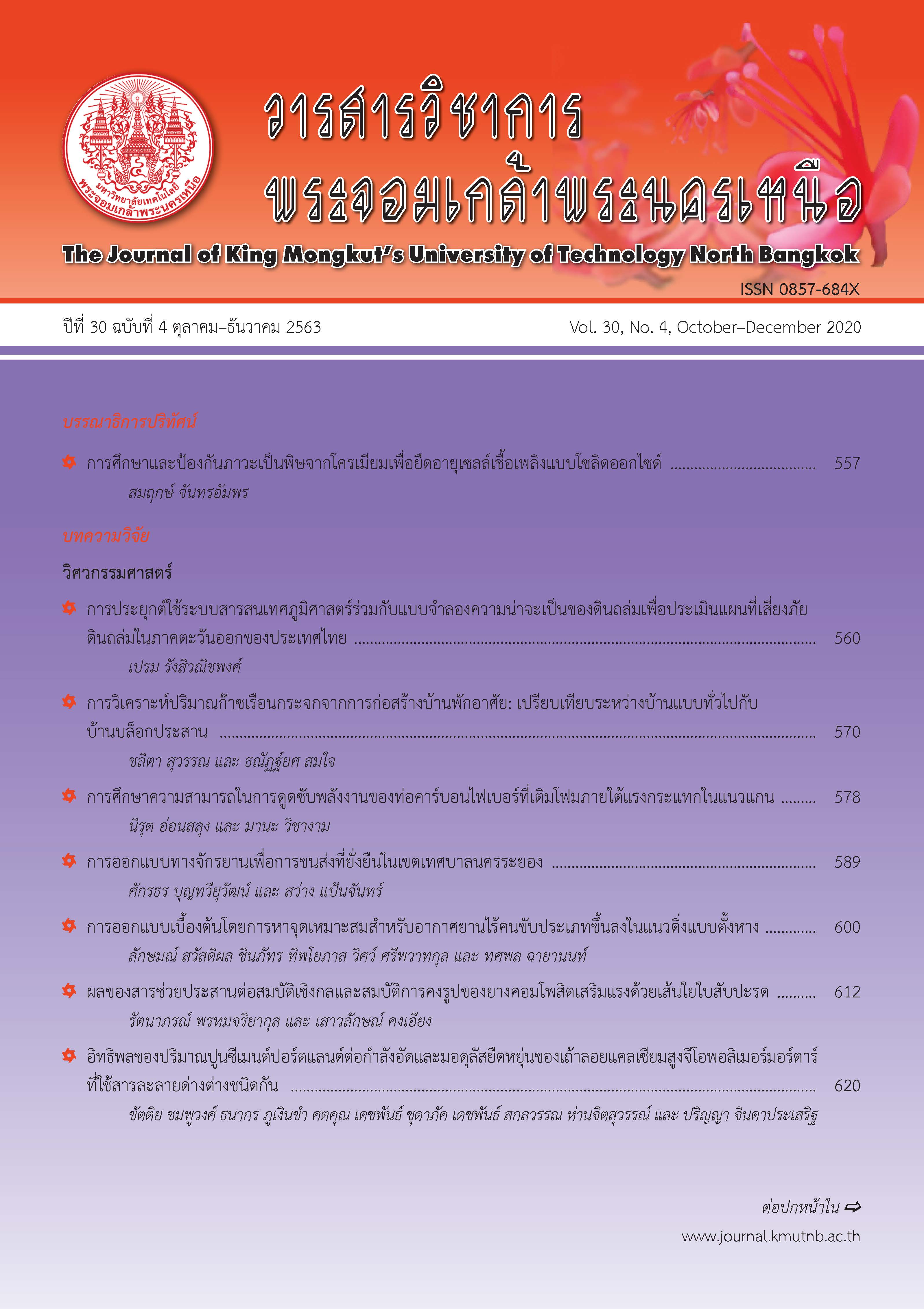การศึกษาความสามารถในการดูดซับพลังงานของท่อคาร์บอนไฟเบอร์ที่เติมโฟมภายใต้แรงกระแทกในแนวแกน
Main Article Content
บทคัดย่อ
งานวิจัยนี้เป็นการศึกษาเชิงทดลองเพื่อหาความสามารถในการดูดซับพลังงานของท่อคาร์บอนไฟเบอร์เติมโฟมภายใต้แรงกระแทกในแนวแกนที่มีการเรียงทับซ้อนและมุมไขว้ที่แตกต่างกัน 6 รูปแบบ ชิ้นงานที่ใช้ในการทดลองขึ้นรูปด้วยระบบสุญญากาศและเติมโฟมชนิดพอลิยูรีเทน ความหนาแน่น 50, 100 และ 150 กิโลกรัมต่อลูกบาศก์เมตร ชิ้นงานถูกทดสอบภายใต้แรงกระแทกด้วยเครื่องทดสอบการกระแทก โดยใช้ความเร็วของหัวค้อน 6.76 เมตรต่อวินาที ณ จุดตกกระทบ ผลการศึกษาพบว่า ลักษณะการเสียหายของชิ้นงานมี 2 ลักษณะ คือ แบบที่ 1 เสียหายแบบแตกแยกและบานออกจากกัน พบในกลุ่มการวางมุมของเส้นใย [0/90] แบ่งเป็น 2 ส่วน คือ ยุบเข้าด้านในท่อแล้วบานออกด้านนอกของท่อ การเสียหายแบบที่ 2 จะเกิดการเสียหายแบบแตกแยกและบานออกจากกันในแนวเฉือน ซึ่งพบในกลุ่มการวางมุมของเส้นใย [45/-45] และเมื่อพิจารณาอิทธิพลของความหนาแน่นโฟมพบว่า ชิ้นงานที่มีความหนาแน่นโฟมเพิ่มขึ้นส่งผลทำให้ค่าภาระสูงสุดและภาระเฉลี่ยสูงขึ้นแต่ส่งผลทำให้ค่าพลังงานดูดซับมีแนวโน้มลดลงเนื่องจากชิ้นงานมีความแข็งเพิ่มขึ้นเกิดการยุบตัวน้อยลง
Article Details
บทความที่ลงตีพิมพ์เป็นข้อคิดเห็นของผู้เขียนเท่านั้น
ผู้เขียนจะต้องเป็นผู้รับผิดชอบต่อผลทางกฎหมายใดๆ ที่อาจเกิดขึ้นจากบทความนั้น
เอกสารอ้างอิง
[2] N. Onsalung, C. Thinvongpituk, and A. Teeboonma, “Study on the crashworthiness of model bus side frame under crushing load,” KKU Engineering Journal, vol. 34, no. 3, pp. 343–354, 2007 (in Thai).
[3] N. Onsalung, C. Thinvongpituk, V. Junchuan, and K. Pianthong, “Crush response of polyurethane foam-filled aluminium tube subjected to axial loading,” in Proceedings The 3rd TSME International Conference on Mechanical Engineering, Chiang Rai, 2012, pp. 534–541 (in Thai).
[4] L. N. S. Chiu, B. G. Falzon, D. Ruan, S. Xu, R. S. Thomson, B. Chen, and W. Yan, “Crush responses of composite cylinder under quasi-static and dynamic loading,” Composite Structures, vol. 131, pp. 90–98, 2015.
[5] J. Zhou, Z. Guan, and W. J. Cantwell, “The energy-absorbing behavior of composite tube-reinforced foams,” International Journal of Composites Part B : Engineering, vol. 139, pp. 227–237, 2018.
[6] T. A. Sebaey and E. Mahdi, “Filler strengthening of foam-filled energy absorption devices using CFRP beam,” International Journal of Composite Structures, vol. 160, pp. 1–7, 2017.
[7] N. Onsalung, C. Thinvongpituk, and K. Pianthong, “Impact response of circular aluminum tube filled with polyurethane foam,” Materials Transactions, vol. 55, no. 1, pp. 207–215, 2014.
[8] S. E. Alkhatib, F. Tarlochan, A. Hashem, and S. Sassi, “Collapse behavior of thin-walled corrugated tapered tubes under oblique impact,” International Journal of Thin-Walled Structures, vol. 122, pp. 510–528, 2018.
[9] Lu Wang, Weiqing Liu, Yuan Fang, Li Wan, and Ruili Huo, “Axial crush behavior and energy absorption capability of foam-filled GFRP tubes manufactured through vacuum assisted resin infusion process,” International Journal of Thin-Walled Structures, vol. 98, pp. 263–273, 2016.
[10] M. Mahbod and M. Asgari, “Energy absorption analysis of a novel foam-filled corrugated composite tube under axial and oblique loadings,” International Journal of Thin-Walled Structures, vol. 129, pp. 58–73, 2018.
[11] P. B. Ataabadi, D. Karagiozova, and M. Alves, “Crushing and energy absorption mechanisms of carbon fiber-epoxy tubes under axial impact,” International Journal of Impact Engineering, vol. 131, pp. 174–189, 2019.
[12] G. Balaji and K. Annamalai, “Crushing response of square aluminium column filled with carbon fibre tubes and aluminium honeycomb,” International Journal of Thin-Walled Structures, vol. 132, pp. 667–681, 2018.

